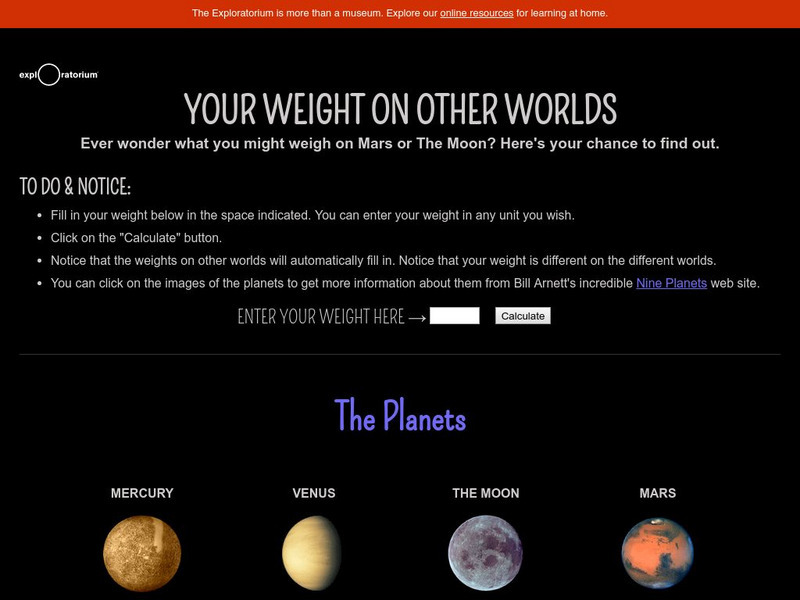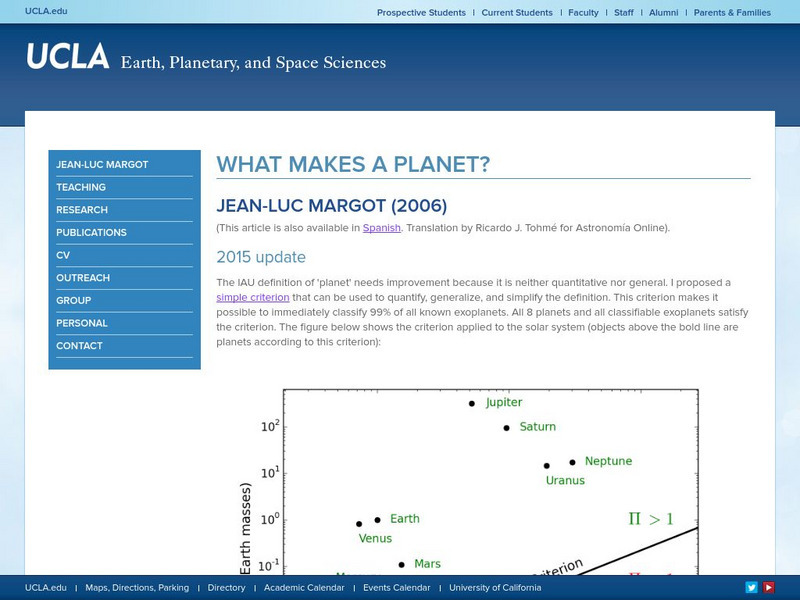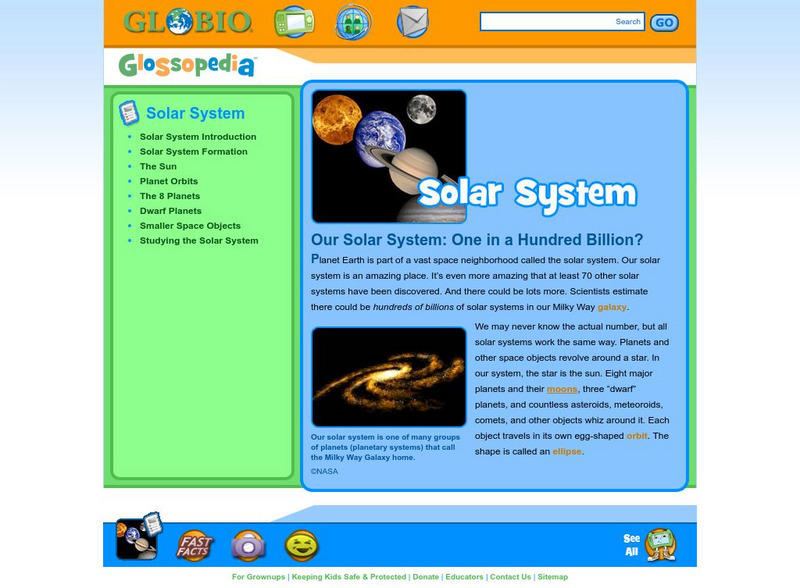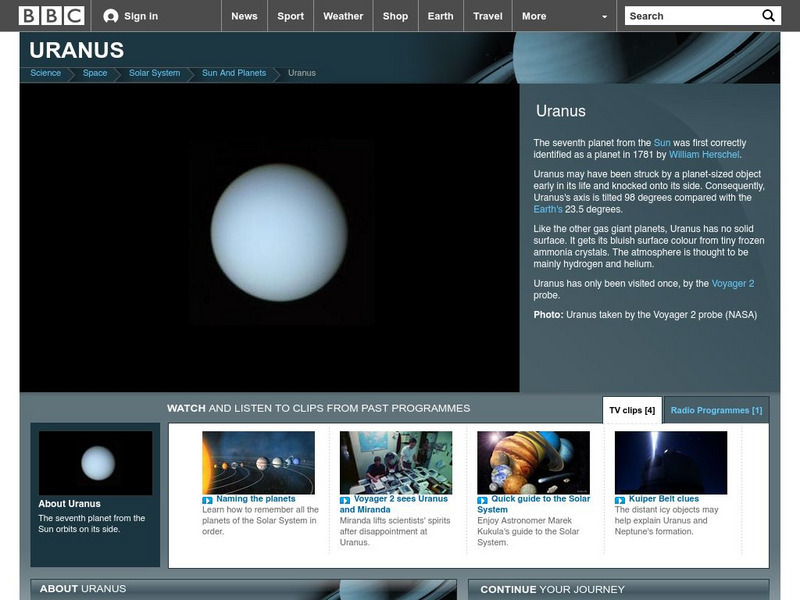DOGO Media
Dogo News: Week of 10 21 13: Does It Rain Diamonds on Saturn and Jupiter?
Article reports on research that suggests that rain on Saturn and Jupiter may be made of diamonds. Includes a brief video.
NASA
Nasa: The Space Place
Do you know what a solar eclipse is? Or how about a galaxy? Space Place has the answers to all your questions about space! Site includes information to explore about planets, satellites, moons, and much more. Also on the website are...
Crayola
Crayola: Extraterrestrials Visit Earth (Lesson Plan)
Your students will love wrapping up a solar system unit with this activity! Children make their own "Travel brochure," about earth, trying to encourage extraterrestrials to visit, by comparing our planet to theirs. This lesson plan also...
PBS
Nova: Anatomy of the Rings
Thanks to the Cassini spacecraft, you can view numerous pictures of Saturn's rings. There are also answers to eleven different questions about the rings.
Exploratorium
Exploratorium: Your Weight on Other Worlds
From the Exploratorium Museum. Includes an interactive feature in which a visitor enters their weight on earth and has their weight on other planets computed and displayed. Discusses the distinction between mass and weight and describes...
Other
University of Leicester: The Solar System
Resource explores the solar system, with an in depth discussion of each of the planets and their properties.
NASA
Nasa: Dare Mighty Things
Explore this interactive timeline to learn about fifty years of planetary exploration. Click on each box for more expanded details.
NASA
Nasa: Night Sky Network: Pocket Solar System
Individual or classroom activity helps students understand the solar system because they can visualize it. Extension resources are included.
Unite for Literacy
Unite for Literacy: Earth and Sky: The Night Sky
Read about the sights you can see in a clear night sky. Book includes audio narration in 16 additional languages with text in English.
University of California
Ucla: What Makes a Planet
This detailed essay defines planets and compares the characteristics to those of Pluto. Orbital graphs and background information clarify the change in Pluto's categorization. A copy of IAU's Resolution 5 is also contained in this essay.
Enchanted Learning
Enchanted Learning: The Planets
This survey of the planets includes all the basics, size, mass, atmosphere, length of day, and the like. It features interactive activities and learning exercises and compares all of the planets in colorful tables.
NASA
Nasa: Welcome to From Earth to the Solar System (Fettss)
A collection of high-resolution images of space. Images "showcase the discoveries and excitement of planetary exploration, with a focus on the origin and evolution of the Solar System and the search for life".
NASA
Nasa: Students K 4
NASA-sponsored coverage and research on a range of topics related to space exploration -- flying weather stations, comets, first steps on the Moon, and other space-related topics -- are presented in age-appropriate activities, lesson...
Globio
Glossopedia: Solar System
Planet Earth is part of a vast space neighborhood called the solar system. Our solar system is an amazing place. It's even more amazing that many other solar systems have been discovered. This article examines the solar system.
Other
Space Science Institute: Alien Earths: Star and Planet Formation
Learn about the lives of stars, and how stars and planets form. The Interactive activity, 'Planet Families' requires Adobe Flash and cannot be launched.
NASA
Nasa: Eyes on the Solar System
This interactive experience allows users to assume different positions and vantage points in space while moving through the Solar System. Also, explore the 2011 Juno spacecraft mission to Jupiter with real-time positioning in space.
BBC
Bbc: Uranus a Mission
Very good narrative about Voyager's mission past Uranus. Details the difficulties of the voyage, as well as containing very good pictures of its moons.
NASA
Nasa: What Is a Planet?
This lesson teaches students about the characteristics of planets, comets, asteroids, and trans-Neptunian objects. After learning about these different things, students then are to debate about a new object that is found in space.
Utah Education Network
Uen: Where Did the Matter in the Universe Come From?
Learners use various articles about how atoms are made and spread throughout the universe starting with the Big Bang. They will study the articles as groups and will then present their information to the class.
Google
Access Mars
Access Mars lets you explore a 3D replica of the Martian surface, exactly as it was recorded by the Curiosity rover.
NASA
Nasa: Kepler and His Laws
This site from NASA provides biographical details about the lives of Tycho Brahe and Johannes Kepler. Discusses Kepler's successes at developing laws of planeatry motion. States the three laws and discusses each one individually....
Cosmos 4 kids
Cosmos4 Kids: Solar System: Neptune
Learn the basic details about the planet Neptune! The brief, to the point text makes this site most suitable for younger researchers.
Cosmos 4 kids
Cosmos4 Kids: Solar System: Uranus
Learn all the basic facts about the planet Uranus. The brief, to the point text makes this site most suitable for younger researchers.
Cosmos 4 kids
Cosmos4 Kids: Solar System: Saturn
Learn the basic facts about the planet Saturn. The brief, to the point text makes this site most suitable for younger researchers.


















